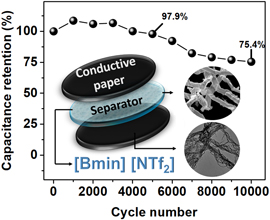Article contents
Renewable supercapacitors based on cellulose/carbon nanotubes/[Bmim][NTf2] ionic liquid
Published online by Cambridge University Press: 03 April 2019
Abstract

Improvement of the performance of renewable electronic devices is a crucial point for the consolidation of this emerging technology. Herein, we develop a supercapacitor based on cellulose, carbon nanotubes, and ionic liquids. A conductive paper prepared by simple acid hydrolysis of cellulose and carboxylated carbon nanotubes was used as an electrode. A cellulose sponge impregnated with 1-n-butyl-3-methylimidazolium bis(trifluoromethane sulfonyl)imide was used as a separator/electrolyte. Electrochemical tests were performed in a two-electrode cell that presented a specific capacitance of 34.37 F/g when considered the active mass and 97.9% of capacitance retention after 5000 charge/discharge cycles.
- Type
- Research Letters
- Information
- Copyright
- Copyright © Materials Research Society 2019
References
- 6
- Cited by




